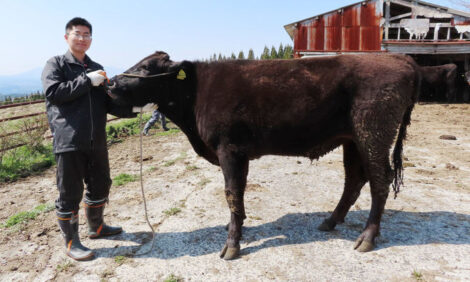



Tough Winter Claims More Livestock in US
US - Higher death loss rates are being reported across all ages of cattle in Kentucky as veterinarians assess the impact of a very testing winter.Advice going out to farmers is to supplement feed until spring grass becomes nutritious enough to support cattle after a winter which has proven too much for cows fed hay alone.
Malnutrition is a perennial issue and every year about this time Dr Michelle Arnold and her team at the Veterinary Diagnostic Laboratory inspect older fallen cattle that have been stripped of fat stores – down to a body condition score of 2-3 – and been termed ‘bloated’ by the owners.
Summing up a typical year, Dr Arnold said: “Despite having had access to free choice hay, these old girls have just 'run out of gas' with a belly full of hay and green grass just around the corner.”
But the 2013/14 winter has caused deaths earlier in the winter and to younger stock, with many pre-weaning calves perishing, says Dr Arnold .
*
"Cows that are malnourished will take more time to get pregnant... a particularly vulnerable group is first-calf heifers"
“It is likely that winter feeding programmes on many farms have been inadequate for pregnant/lactating cows and growing calves.”
Dr Arnold explained that when cattle are wet the critical temperature is at 59°F, which drops to 18°F when dry.
Every degree below critical temperature requires stock to expend two per cent more calories and Dr Arnold claims that many hay rations have not cut the mustard this winter.
“Although hay may look good, unless a producer has had their hay tested for nutritional content, they do not know what the true feed value is,” warned Dr Arnold.
“Producers need to realize that cattle can actually 'starve to death' while consuming all the hay they can eat.”
Subsequently, Dr Louis Pittman, veterinary pathologist at the Breathitt Veterinary Centre has reminded cattlemen that hay with protein levels under four per cent and Total Digestible Nutrients below 30 per cent is not sufficient for a late gestation cow.
He said that a typical 1,200 pound cow requires no less than 54 per cent TDN and eight per cent crude protein in the final 60 days of gestation.
Dr Pittman’s message is that protein is key as calves born from protein deficient dams find it difficult to generate sufficient body heat.
He said: “We have received numerous calls and diagnostic submissions associated with 'weak calf syndrome' or full-term calves which were presumed to have been born dead.”
Moreover, liver inspections show that many cattle are deficient of selenium and copper which should be addressed through mineral supplementation, Dr Pittman added.
This has caused malnutrition cases and herd-wide outbreaks of respiratory disease, including pneumonia in pre-weaned calves, he concluded.
After what has been a costly winter for many, saving money on feed at calving is a false economy which jeopardizes farm profitability through delayed conception.
This is according to beef specialist John Grimes, who has warned his Ohio producers that their bottom line could be damaged if cattle fail to rebreed within 90 days of calving.
"Cows that are malnourished will take more time to get pregnant, so producers need to not get complacent now so they can stay on track," said Mr Grimes. "A particularly vulnerable group is first-calf heifers, as they are still growing and lactating for the first time, and need to be rebred for their second calf.”
The Ohio State University expert warned that cattlemen turning stock out in the coming weeksdays may need to supplement grass with hay or grain.
Mr Grimes suggested that hay is checked before feeding, and added: “It may have lost quality due to extreme weather conditions and might not be good enough to meet nutritional requirements.”
Michael Priestley
News Team - Editor
Mainly production and market stories on ruminants sector. Works closely with sustainability consultants at FAI Farms



